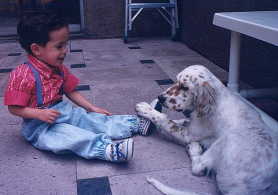


Pets should be
part of children’s lives. Parental
involvement, open discussion, and planning are usually necessary to help make
pet ownership a positive experience for everyone.
A child who learns to care for an animal, and treat it kindly and
patiently, gets invaluable training in learning to treat people the same way.
Careless treatment of animals is unhealthy for both the pet and the child
involved.
Choosing
an Appropriate Pet
While all kinds of pets can bring children pleasure, it is important to choose a pet that is right for your family, your home, and your lifestyle – and one that your child can help care for. Parents should be cautious about having aggressive animals as pets. Remember, even trained and domesticated animals can be aggressive.
Caring
for a Pet
Taking care of a pet can help children develop social skills.
However, certain guidelines apply:
·
Since very young children (under the age of 3-4 years) do not have
the maturity to control their aggressive and angry impulses, they should be
monitored with pets.
·
Young children (under 10 years) are rarely able to care for a large
animal on their own.
·
Parents must oversee the pet’s care even if they believe their
child is old enough to care for a pet.
·
If children become lax in caring for a pet, parents may have to
take over the responsibility on their own.
·
Children should be reminded in a gentle, not scolding way, that
animals, like people, need food, water, and exercise.
·
Parents serve as role models.
Children learn responsible pet ownership by observing their parents’
behavior.
Advantages
of Pet Ownership
Children raised
with pets benefit in a number of ways. Developing
positive feelings about pets can contribute to a child’s self-esteem and
self-confidence. Positive
relationships with pets can aid in the development of trusting relationships
with others. A good relationship
with a pet can also help in developing non-verbal communication, compassion and
empathy. Pets can serve different
purposes for children:
Other physical and emotional needs fulfilled by pet ownership
include:
![]()
Many people are
aware of the health benefits that come from having a pet, including lowering
high blood pressure, preventing heart disease and combating depression.
However, what parents may not realize is that adding Spot or Dolly to a
family can be advantageous to the other bundles of joy “scampering” around
your home – your kids!
While little
children are too young to worry about preventing stress or lowering health care
costs, there are numerous benefits they can experience from having a family pet.
Pets Help Children Gain a Sense of Independence that can set them on
the path to becoming mature, responsible adults.
Pets Teach Kids To Be Responsible.
Children can learn the importance of responsibility at an early age
by acting as a caretaker for a pet. A
pet can present an ideal opportunity for parent and child to bond while caring
for the pet together. Showing
children what is means to be responsible for another creature’s survival can
result in teaching important life lessons such as discipline, patience, kindness
and attentiveness.
Pets Can Help Kids Develop Discipline.
Walking the dog can serve as fun study breaks for kids, and a
replacement for television programs and video games. These pet-related activities help children remain focused on
the task at hand.
Pets Prepare Kids For Life Situations.
Bringing a pet home and into the family can be an effective way to
help prepare children for real life scenarios.
For example, pets can ease the transition of suddenly having to share mom
and dad’s attention with a new brother or sister by demonstrating how much fun
new playmates can be. They can
teach them about caring for others. Pets
can also help kids learn to deal with medical issues and illnesses as they are
exposed to routine veterinarian check-ups with their pet, and the treatments for
various ailments.
[PET PRESS & ANIMAL NEWS, June 2003]
